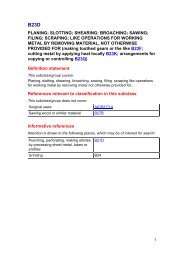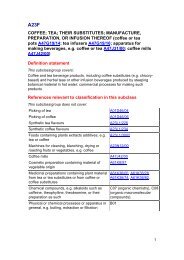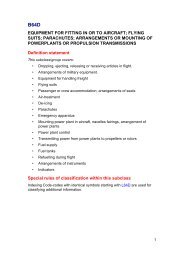A61K - Cooperative Patent Classification
A61K - Cooperative Patent Classification
A61K - Cooperative Patent Classification
Create successful ePaper yourself
Turn your PDF publications into a flip-book with our unique Google optimized e-Paper software.
CPC - <strong>A61K</strong> - 2013.07 - page 52<br />
<strong>A61K</strong> 47/183 . . . . { Amino acids or aminosulphonic acids, e.g. glycine, EDTA, aspartame }<br />
<strong>A61K</strong> 47/186 . . . . { Quaternary ammonium compounds, e.g. benzalkonium chloride, cetrimide }<br />
<strong>A61K</strong> 47/20 . . containing sulfur, { e.g. DMSO, docusate, sodium lauryl sulfate ( <strong>A61K</strong> 47/183 ,<br />
<strong>A61K</strong> 47/186 take precedence ) }<br />
<strong>A61K</strong> 47/22 . . Heterocyclic compounds, { e.g. ascorbic acid, tocopherol, pyrrolidones ( <strong>A61K</strong><br />
47/183 , <strong>A61K</strong> 47/186 take precedence ) }<br />
<strong>A61K</strong> 47/24 . . containing atoms other than carbon, hydrogen, oxygen, halogen, nitrogen or sulfur,<br />
{ e.g. cyclomethicone, phospholipids }<br />
<strong>A61K</strong> 47/26 . . Carbohydrates, { e.g. mono-, di-, oligosaccharides, nucleic acids, sugar alcohols,<br />
amino sugars; Derivatives thereof, e.g. polysorbates, sorbitan fatty acid esters,<br />
glycyrrhizin ( <strong>A61K</strong> 47/183 , <strong>A61K</strong> 47/186 take precedence ) }<br />
<strong>A61K</strong> 47/28 . . Steroids, { e.g. cholesterol, bile acids, glycyrrhetinic acid ( <strong>A61K</strong> 47/183 , <strong>A61K</strong><br />
47/186 take precedence ) }<br />
<strong>A61K</strong> 47/30 . Macromolecular compounds<br />
<strong>A61K</strong> 47/32 . . Macromolecular compounds obtained by reactions only involving carbon-to-carbon<br />
unsaturated bonds, { e.g. carbomers, poly(meth)acrylates, polyvinyl pyrrolidone }<br />
<strong>A61K</strong> 47/34 . . Macromolecular compounds obtained otherwise than by reactions only involving<br />
carbon-to-carbon unsaturated bonds, { e.g. polyesters, polyamino acids,<br />
polysiloxanes, copolymers of polyalkylene glycol or poloxamer ( PEG or<br />
poloxamers <strong>A61K</strong> 47/10 ) }<br />
NOTE<br />
-<br />
This group does not cover polyalkoxylated compounds, which are classified<br />
according to the derivatized compounds. The following list provides examples<br />
of such polyalkoxylated compounds together with their relevant group:<br />
- POE alkyl ethers <strong>A61K</strong> 47/10<br />
- PEG fatty acid esters <strong>A61K</strong> 47/14<br />
- poloxamines <strong>A61K</strong> 47/18<br />
- polysorbates <strong>A61K</strong> 47/26<br />
- POE castor oil <strong>A61K</strong> 47/44<br />
<strong>A61K</strong> 47/36 . . Polysaccharides ; Derivatives thereof, { e.g. gums, starch, alginate, dextrin,<br />
hyaluronic acid, chitosan, inulin, agar, pectin }<br />
<strong>A61K</strong> 47/38 . . . Cellulose ; Derivatives thereof<br />
<strong>A61K</strong> 47/40 . . . Cyclodextrins ; Derivatives thereof { ( cyclodextrin inclusion compounds <strong>A61K</strong><br />
47/48969 ) }<br />
<strong>A61K</strong> 47/42 . . Proteins ; Polypeptides ; Degradation products thereof ; Derivatives thereof { e.g.<br />
albumin, gelatin, zein ( oligopeptides having up to 5 amino acids <strong>A61K</strong> 47/183 ;<br />
polyamino acids <strong>A61K</strong> 47/34 ) }<br />
<strong>A61K</strong> 47/44 . Oils, fats or waxes according to more than one of groups <strong>A61K</strong> 47/02 to <strong>A61K</strong> 47/42 ;<br />
{ Natural or modified natural oils, fats or waxes, e.g. ( polyethoxylated ) castor oil,<br />
montan wax, ozokerite, lignite, shellac, rosin, beeswax, lanolin ( synthetic glycerides,<br />
e.g. medium-chain triglycerides <strong>A61K</strong> 47/14 ) }<br />
<strong>A61K</strong> 47/46 . Ingredients of undetermined constitution or reaction products thereof, { e.g. skin, bone,<br />
milk, cotton fiber, eggshell, oxgall, plant extracts }<br />
<strong>A61K</strong> 47/48 . the non-active ingredient being chemically bound to the active ingredient, e.g. polymer<br />
drug conjugates<br />
<strong>A61K</strong> 47/48007 . . { the pharmacologically- or therapeutically-active agent being covalently bound or





